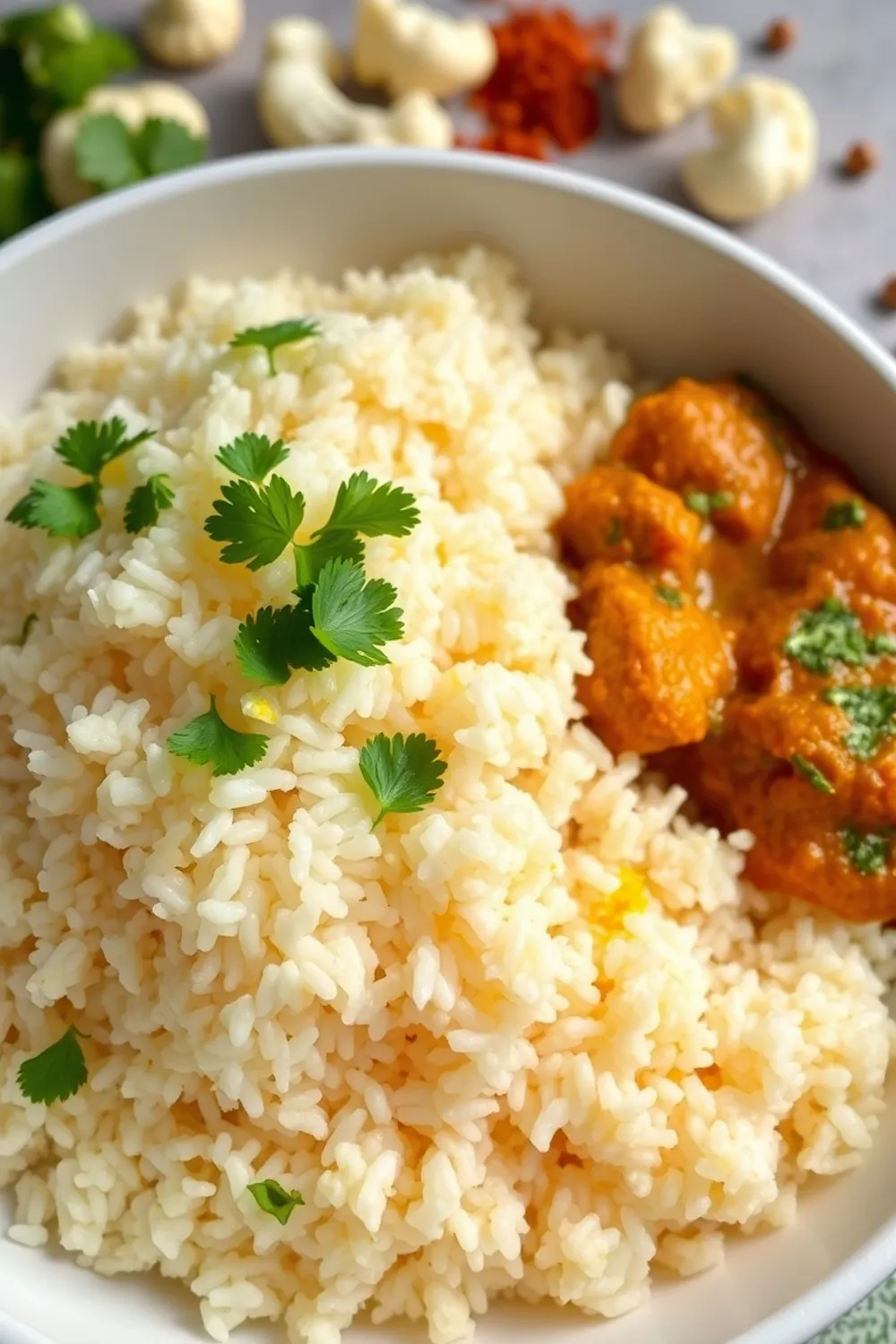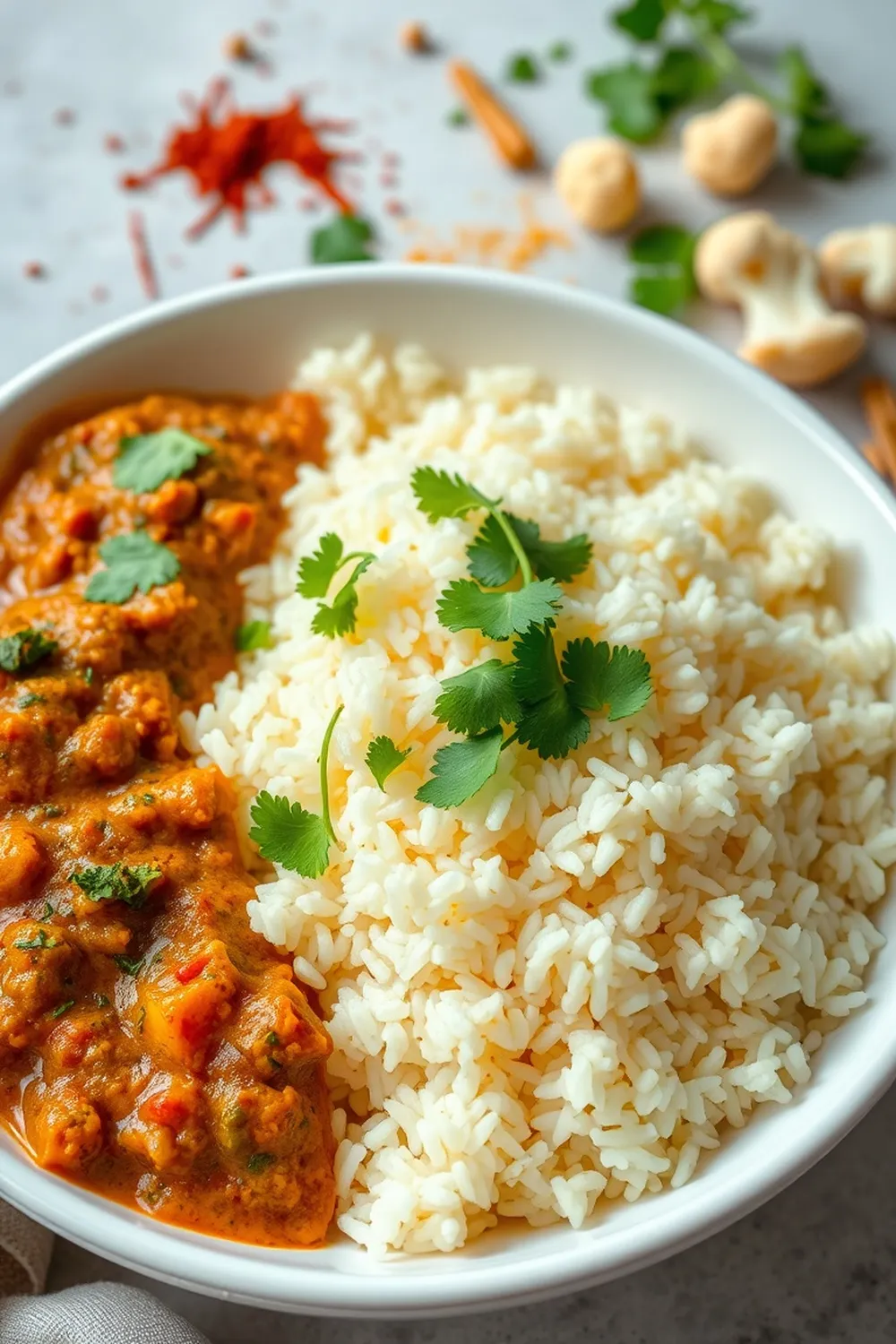- Rinse and dry cauliflower thoroughly. Remove outer leaves and cut florets from the stems, keeping about an inch of stem.
- Use a food processor: Add florets (up to 3/4 of the bowl) and pulse 15 times until rice-sized. Scrape sides as needed.
- Alternatively, grate florets with a grater, chop finely with a chef's knife, or blend in small batches (4-5 pulses).
- Heat oil in a pan over medium heat. Add riced cauliflower and sauté for 4 minutes until tender, stirring frequently.
- Season with salt and pepper, and garnish with herbs. Serve warm with curries or as a low-carb base.
- Calories:135 kcal25%
- Energy:564 kJ22%
- Protein:3 g28%
- Carbohydrates:15 mg40%
- Sugar:3 mg8%
- Salt:150 g25%
- Fat:5 g20%
Last Updated on 6 months ago by Neha Deshmukh
Cauliflower Rice Recipe – Easy Indian Low-Carb Side Dish
Hey everyone! If you’re anything like me, you’re always looking for ways to sneak in extra veggies and keep things light without sacrificing flavour. This cauliflower rice recipe is a total game-changer. It’s become a regular in my kitchen, especially when I’m craving Indian food but want a healthier side. Trust me, once you try it, you’ll be hooked!
Why You’ll Love This Recipe
This isn’t just another low-carb trend; it’s a genuinely delicious and versatile way to enjoy your favourite Indian curries. Cauliflower rice takes on the flavours of whatever you pair it with beautifully. Plus, it’s super quick to make – ready in under 30 minutes! It’s perfect for busy weeknights or when you’re hosting and want a lighter option.
Ingredients
Here’s what you’ll need:
- 1 cauliflower head
- 1 tablespoon oil (I prefer coconut oil or ghee for an Indian touch!)
- ½ teaspoon kosher salt (or to taste)
- ¼ teaspoon black pepper (or to taste)
- 1 tablespoon parsley or cilantro, chopped (for garnish)
Ingredient Notes
Cauliflower is a real superstar. It’s incredibly adaptable and takes on flavours so well. It’s a fantastic substitute for rice, especially if you’re watching your carbs or just want to add more vegetables to your diet.
Don’t be afraid to experiment with the oil! Ghee adds a lovely nutty flavour that complements Indian spices beautifully. And fresh herbs? They just brighten everything up. I always have cilantro on hand, but parsley works wonderfully too.
Step-By-Step Instructions
Let’s get cooking! First things first, give your cauliflower a good rinse and dry it thoroughly. Remove the outer leaves and carefully cut the florets from the stem, leaving about an inch of stem attached – this helps with grating or processing.
Now, you have a couple of options for “ricing” the cauliflower. I usually use a food processor. Add the florets (don’t overcrowd the bowl – work in batches!) and pulse about 15 times until it resembles rice. Don’t overdo it, you don’t want a puree! Scrape down the sides as needed.
If you don’t have a food processor, no problem! You can grate the florets with a box grater, chop them really finely with a chef’s knife, or even blend them in small batches (4-5 pulses should do it).
Heat the oil in a pan over medium heat. Add the riced cauliflower and sauté for about 4-5 minutes, stirring frequently, until it’s tender but still has a little bite. You don’t want it mushy!
Finally, season with salt and pepper to taste. Garnish with your chopped parsley or cilantro and serve warm. That’s it!
Expert Tips
The key to perfect cauliflower rice is texture. You want it to resemble rice, not a paste. Pulse carefully in the food processor, and don’t overcook it when sautéing.
If your cauliflower seems a little wet after ricing, you can squeeze out the excess moisture using a clean kitchen towel. This will help it get nice and slightly crispy in the pan.
Variations
- Vegan: This recipe is naturally vegan! Just ensure you’re using a plant-based oil.
- Gluten-Free: Absolutely gluten-free!
- Spice Level: This is where things get fun! Add a pinch of turmeric for colour and health benefits, a dash of cumin for warmth, or a sprinkle of chili powder for a little kick. My friend, Priya, loves adding a pinch of garam masala – it’s amazing!
- Festival Adaptations: This is fantastic for Navratri or any fasting period where you avoid grains. It’s a satisfying and flavourful base for your vrat recipes.
Serving Suggestions
Cauliflower rice is incredibly versatile. Here are a few of my favourite pairings:
- North Indian: Serve it with a rich butter chicken or a flavourful chana masala.
- South Indian: It’s delicious with sambar, rasam, or a spicy vegetable korma.
- East Indian: Try it alongside a fragrant fish curry or a flavourful dal.
Honestly, it goes with almost anything!
Storage Instructions
You can store leftover cauliflower rice in an airtight container in the refrigerator for up to 3 days. To reheat, simply sauté it in a pan with a little oil until warmed through. You can also freeze it, but the texture might change slightly.
FAQs
- Is cauliflower rice a good substitute for regular rice? Absolutely! It’s a great way to reduce carbs and add more vegetables to your diet. It won’t taste exactly like rice, but it’s a delicious alternative.
- Can I make cauliflower rice ahead of time? Yes, you can! You can rice the cauliflower and store it in the fridge for a day or two before cooking.
- What is the best way to prevent cauliflower rice from becoming mushy? Don’t over-process it and don’t overcook it. Keep a close eye on it while sautéing.
- Can I use frozen cauliflower to make cauliflower rice? Yes, you can! Just make sure to thaw it completely and squeeze out any excess moisture before ricing.
- What are some other ways to season cauliflower rice beyond salt and pepper? The possibilities are endless! Try garlic powder, onion powder, paprika, herbs, or even a squeeze of lemon juice.







